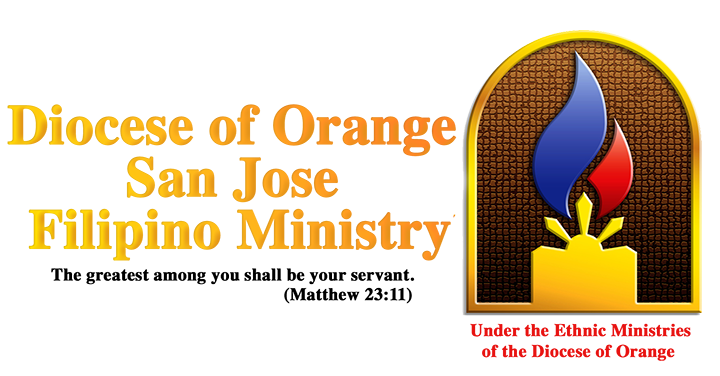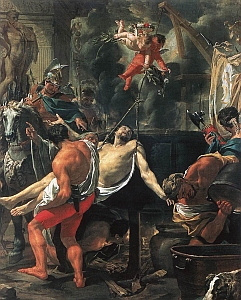Caterina di Jacopo di Benincasa (Catherine) was the twenty-third or twenty-fourth child born to loving parents in the thriving city of Siena, Italy. Her twin, as well as half of her twenty-four siblings, did not survive infancy. As a child, Catherine stood out. She was given the nickname “Euphrosyne,” which means “joy,” because of her joyful disposition and deep devotion to God from an early age. At the age of five, she would climb the stairs in her home on her knees as she prayed the Hail Mary on each step. At the age of six, while she was out walking with her brother, she had the first of many visions. She saw Jesus, sitting on a throne, crowned as King, surrounded by Saints Peter, Paul, and John. This supernatural experience drew Catherine even more deeply into a life of childhood prayer, penance, and devotion. Within a year, she had made a personal vow to give her whole life to God. Her prayer life was so evident that her parents gave her a bedroom in the basement so that she could use it as her own personal place of prayer. This “cell” in which she lived and prayed was also in her soul. She would later relate to her spiritual director that when she was troubled or tempted, she would build a cell inside her mind, from which she could never flee. Her prayer life also increased her virtues, and she treated her father as Jesus, her mother as Mary, and her siblings as the Apostles.
When Catherine was a teenager, she firmly opposed her parents’ desire that she marry. She wanted to be devoted to God alone, so she began fasting and praying. She even went so far as to cut her hair short so that she would be less attractive to young men. Eventually, her parents accepted her vocation.
In 1363, just three days after her sixteenth birthday, Catherine joined the Third Order of Saint Dominic. The Third Order was made up of lay people who wore a religious habit but lived at home and worked in the world rather than in a cloister. They served the poor and sick and performed charitable works. For the first several years as a Third Order Dominican, Catherine lived mostly a life of seclusion and prayer. Around the age of twenty-one, she entered into what would later be described as “mystical marriage” with our Lord. While praying, Jesus appeared to her, along with the Virgin Mary and King David as a harpist. Jesus placed a ring on her finger and departed. The ring remained for the rest of her life, although Catherine was the only one who could see it.
Two centuries later, the Spanish Mystic, Saint Teresa of Ávila, would describe mystical marriage this way in her spiritual classic, Interior Castle:
When our Lord is pleased to take pity on the sufferings, both past and present, endured through her longing for Him by this soul which He has spiritually taken for His bride, He, before consummating the celestial marriage, brings her into this His mansion or presence chamber. This is the seventh Mansion, for as He has a dwelling-place in heaven, so has He in the soul, where none but He may abide and which may be termed a second heaven.
Saint Teresa went on to explain that this celestial marriage, this second heaven, is a permanent gift bestowed upon a soul. By His divine foreknowledge, when He is aware of the permanent sanctity of a soul, He bestows this gift of divine union upon the soul. Catherine was one of those who received this rare gift.
After receiving the gift of spiritual marriage, Catherine began a more active ministry to the poor, sick, and imprisoned of Siena. When the bubonic plague—“Black Death”—struck Siena, Catherine and her companions remained hard at work, caring for those affected. Catherine also began to get involved in controversies that were plaguing the Church and State. She wrote hundreds of letters to kings, queens, nobility, religious, priests, and even to the pope himself. At that time, the divisions in the Church were so profound that Catherine engaged in severe penance and prayer. For example, she no longer ate or drank, living only on the Holy Eucharist which she received every day. While in Pisa in 1375, Catherine learned of rebellions within the Church. She fell into ecstasy and received the gift of an invisible stigmata, which appeared physically on her body only after her death. She saw a vision of our crucified Lord and rays of light extended from Jesus’ body to hers, piercing her through.
A dominant focus of her letters to the pope was to urge him to return to Rome. At that time, the papacy had moved to Avignon, France, which became the cause of much internal Church conflict. Anti-popes were elected and confusion was widespread. Catherine knew that the Holy Father, “daddy” as she called him, needed to return to the Eternal City to end the chaos. Her letters, and later her face-to-face conversations, were not only directed to the Holy Father with the affection and sincerity of a loving spiritual daughter, they were also firm, direct, and challenging. In one letter to Pope Gregory XI, she wrote urging him to return to Rome: “I tell you, father in Christ Jesus, come swiftly like a gentle lamb. Respond to the Holy Spirit Who calls you. I tell you, Come, come, come, and do not wait for time, since time does not wait for you.” The pope listened and returned to Rome in 1377. The last few years of Catherine’s life were spent writing letters, visiting towns that were warring against the papacy, and consulting two popes, first Pope Gregory XI and then his successor Pope Urban VI. She rallied the people, gained many followers, addressed political, cultural, and moral abuses, and gave an ongoing witness to Christ crucified through her penitential life.
Her last, and perhaps greatest, gift to the Church was her book entitled, The Dialogue of Divine Providence. It is believed that this book was dictated by Catherine while she remained in ecstasy. It is a conversation between a soul and the Father in Heaven. In addition to this great spiritual masterpiece, 382 of her letters and twenty-six of her prayers have survived.
Saint Catherine was one of the greatest and most influential saints in the history of the Church. In her lifetime she had a powerful impact upon those she encountered, including the pope. In her death, she continues to have a profound impact upon the Church as a Doctor of the Church. None of that would have been possible had she not engaged in fervent prayer and penance throughout her life. Ponder your own prayer life as we honor Saint Catherine, and strive to imitate her burning love for her Lord, her Divine Spouse. That love, fueled by a unquenchable desire for God, is beautifully seen in the following prayer that she herself wrote:
Prayer: Eternal God, eternal Trinity, You have made the Blood of Christ so precious through His sharing in Your Divine nature. You are a mystery as deep as the sea; the more I search, the more I find, and the more I find, the more I search for You. But I can never be satisfied; what I receive will ever leave me desiring more. When You fill my soul, I have an ever greater hunger, and I grow more famished for Your light. I desire above all to see You, the true Light, as You really are. Amen.
Saint Catherine of Siena, pray for me. Jesus, I trust in You.
Source: https://mycatholic.life/saints/saints-of-the-liturgical-year/april-29-saint-catherine-of-siena-virgin-and-doctor-of-the-church/













